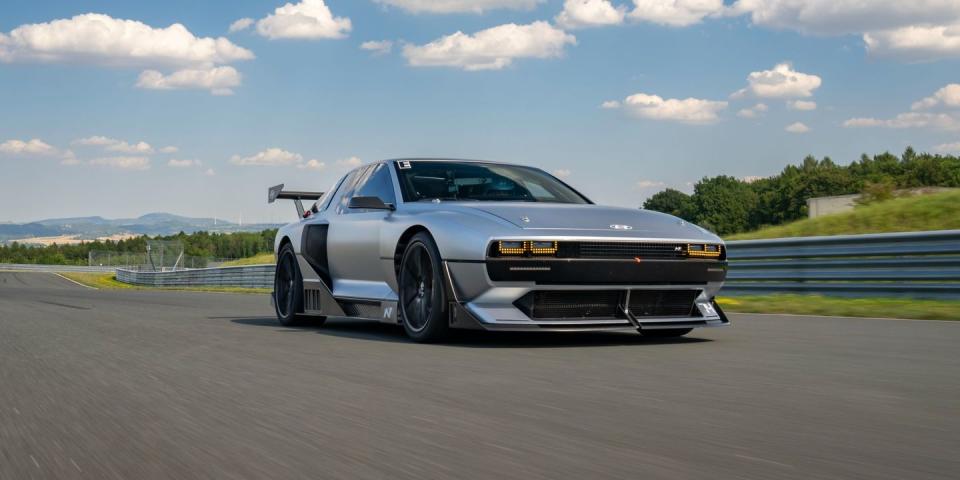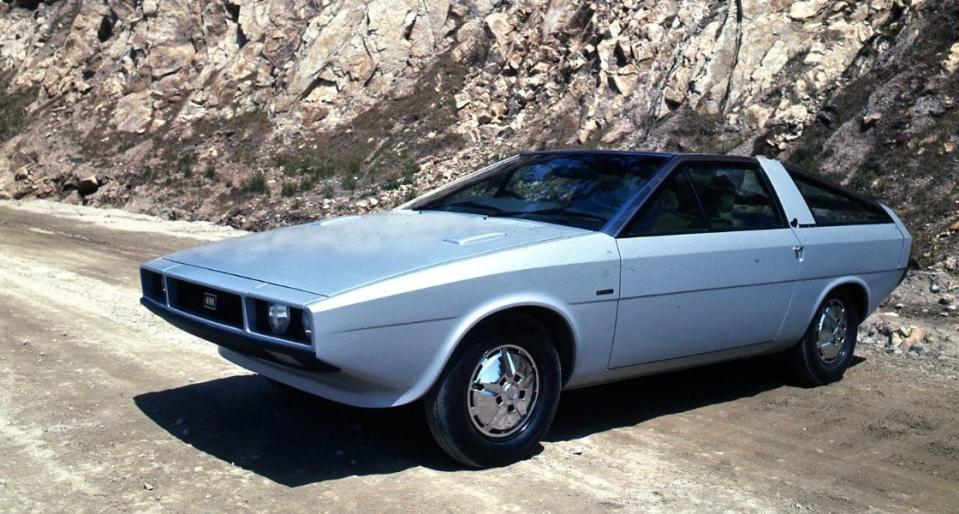Climbing Behind the Wheel of a Hydrogen-Powered Fuel Cell Muscle Car

The N Vision 74 hydrogen fuel cell car has 670 hp, rear-wheel drive, and a claimed 370 miles of range.
The design was inspired by the car Giugiaro turned into the Delorean DMC-12, the Hyundai Pony Coupe concept.
Sadly, the automaker has no plans to put the N Vision 74 into production.
The battery electric era is already arriving, but a big question remains over what will follow it. A significant percentage of the auto industry holds that BEVs will be the long-term answer. They are, in essence, betting that the issues of range, cost, finding materials for battery packs—and the challenge of recycling old cells—will all be answered in time.
Yet others believe that battery-powered EVs will only be an interim solution, one that will eventually be supplemented by hydrogen power through fuel cells.
This isn’t outer-edge stuff. Two of the biggest automakers in the world—Toyota and Hyundai—are committed to hugely expensive fuel cell programs, and both have already put hydrogen-powered vehicles into limited production. But these cars, the Mirai and Nexo respectively, are worthy and unexciting, certainly from everything but a technical point of view. Now meet one that’s not.
In truth Hyundai’s spectacular N Vision 74 concept isn’t a pure hydrogen car so much as a hydrogen-assisted EV. Nor are there any plans to put it into production with any type of powerplant. But it looks great, delivers up to 690 hp through its rear axle, and is fully capable of smoking its back tires while travelling sideways. There’s also a genuine reason it looks a little bit like a Delorean DMC-12—and Autoweek has driven it.

The N Vision 74 earned huge amounts of online praise when it was first unveiled earlier this year, but the muscular coupe isn’t just a pretty show concept. Indeed, beneath its bodywork lies a hard-working prototype powertrain, one that was created well before the idea of turning it into a stylish coupe was hatched.
The core structure isn’t a Hyundai; rather, it’s a Kia Stinger. That’s according to Albert Biermann, formerly the group R&D boss, and instigator of its N performance division. Now he is semi-retired and has the job title “executive technical adviser”—one that gives him the ability to give more behind the scenes details than the company’s PR team probably want him to.
According to Biermann, four Stingers were modified to create what Hyundai calls “mecha-protos,” ones built on an existing car, to trial a new high-output system that combines a 62.4-kWh battery and an 85-kW fuel cell. These send power to a pair of 335-hp electric motors at the back, one turning each rear wheel. The project’s main purpose was actually to help develop the system that regulates the relationship between the two e-motors in lieu of any mechanical connection across the axle.
“We developed a ‘virtual differential’ by software control,” Biermann says, “and that’s been a huge challenge for our engineers. But at some point we might consider [using] it for a special car needing more power than our modular system can provide with one motor at each axle.”
Given the group’s most potent current EV architecture offers 577-hp using separate motors for front and rear, that suggests there will be some seriously high performance models in Hyundai’s future.
The N Vision 74’s muscular coupe bodywork came later, and is the work of a team under the leadership of Hyundai’s Executive Vice President of Design, Lee SangYup. Lee knows plenty about making good-looking sports cars; before joining Hyundai he worked for GM, Volkswagen, and Bentley, with previous credits including the Cadillac Sixteen concept, the fifth-generation Chevrolet Camaro, and the spectacular Bentley EXP 10 Speed 6.

Inspiration for the N Vision 74 came from the very beginning of Hyundai’s history as an independent maker. Having graduated from building Fords under licence in the mid-‘70s, the company’s first car was the Pony sedan. Although designed to offer low-cost transport in South Korea, and later some export markets, this was designed by ItalDesign’s Giorgetto Giugiaro.
Wanting something more exciting for auto show stands, Hyundai also commissioned the legendary designer to create a Pony coupe concept sitting on the same platform. To no great surprise, this featured the wedgy proportions of some of Giugiaro’s more famous cars from the era, that list including the Lotus Esprit and the Alfa Romeo Alsasud Sprint.

 Yahoo Autos
Yahoo Autos 